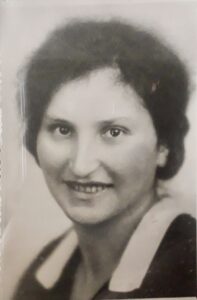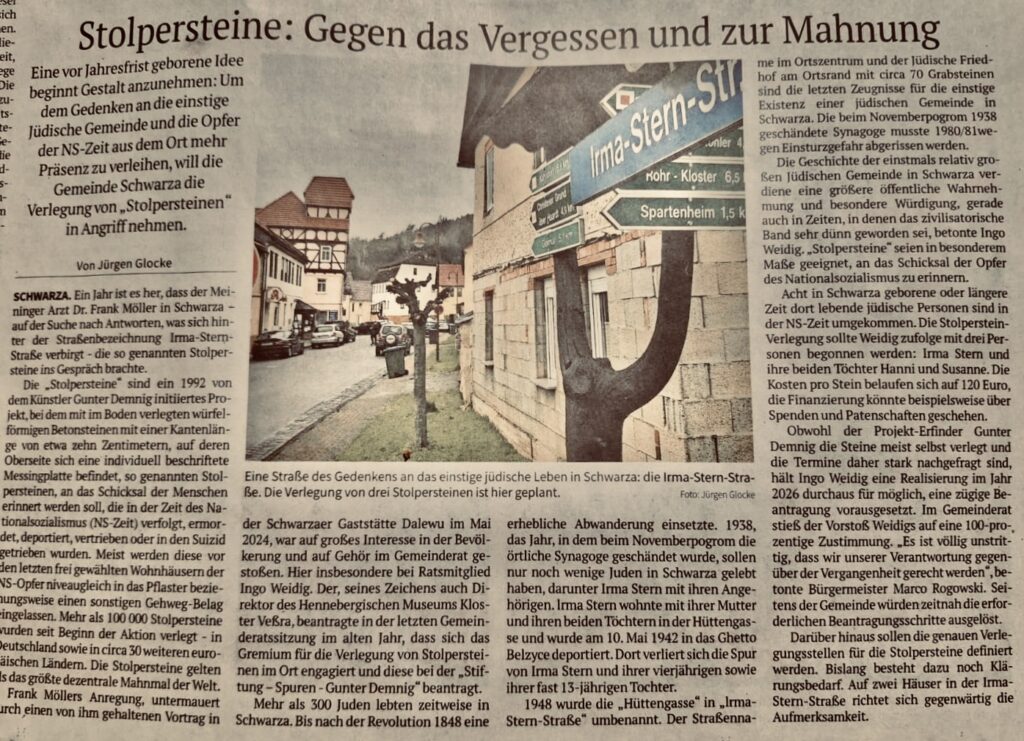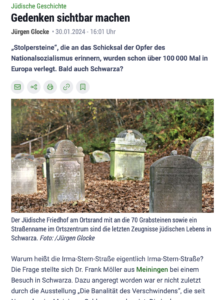 The story of Irma Stern, her two daughters, and mother took place in the village of Schwarza near Meiningen. In 2023, Dr. Frank Möller set out to discover the story of the family during the Nazi regime and Holocaust, bring it to the attention of today’s world, and, he hoped, have “Stolpersteine” laid in their honour.
The story of Irma Stern, her two daughters, and mother took place in the village of Schwarza near Meiningen. In 2023, Dr. Frank Möller set out to discover the story of the family during the Nazi regime and Holocaust, bring it to the attention of today’s world, and, he hoped, have “Stolpersteine” laid in their honour.
Frank and I connected because Irma and her two young daughters were deported to Belzyce Ghetto on 10 March 1942 and he found their names in the Belzyce Ghetto website as well as in the geni.com profiles.
Much of Frank Möller’s quest has been told in the newspaper articles below. In early January 2025, the Gemeinderat/district council voted to lay Stolpersteine in Schwarza, the first to be those for Irma and her two daughters.
*****
“Stolpersteine: Against Forgetting and a Reminder”
9 January 2025
 An idea born a year ago is beginning to take shape: In order to give more presence to the memory of the former Jewish community and the victims of the Nazi era from the town, the municipality of Schwarza wants to tackle the laying of “stumbling stones”.
An idea born a year ago is beginning to take shape: In order to give more presence to the memory of the former Jewish community and the victims of the Nazi era from the town, the municipality of Schwarza wants to tackle the laying of “stumbling stones”.
by Jürgen Glocke
SCHWARZA. A year ago, Dr. Frank Möller, a doctor from Meiningen, started talking about the so-called “Stolpersteine” or “stumbling stones” in Schwarza in his search for answers as to what lies behind the street name “Irma-Stern-Straße.”
Stolpersteine are a project initiated in 1992 by the artist Gunter Demnig, in which cube-shaped concrete stones with an edge length of around ten centimetres, on the top of which there is an individually inscribed brass plate, so-called stumbling blocks, are laid in the ground to commemorate the fate of the victims, the National Socialist era. These are usually set into the pavement or other sidewalk surface at the same level in front of the last freely chosen homes of the Nazi victims. More than 100,000 Stolpersteine have been laid since the campaign began – in Germany and around 30 other European countries. The Stolpersteine are considered the largest decentralized memorial in the world.
Frank Möller’s suggestion, underpinned by a lecture he gave in of the Schwarza restaurant Dalewu in May 2024, found support among the audience and a hearing at the district council. In particular, council member Ingo Weidig, who is also director of the Henneberg Museum Kloster Veßra, had put forward a request at the last municipal council meeting in 2024. Committee for the Transfer of Stolperstein Foundation – Traces – Gunter Demnig”.
At times, more than 300 Jews lived in Schwarza. After the revolution of 1848, however, a marked emigration occurred. In 1938, the year in which the synagogue was desecrated in the November pogrom, only a few Jews still lived in Schwarza, including Irma Stern with her relatives. Irma Stern lived with her mother and her two daughters in the Hüttengasse Irma and the two young girls were deported on May 10, 1942 to the Belzyce Ghetto. No further trace has been found of Irma and her 4-year-old and almost 13-year-old daughters.
The town center and the Jewish cemetery on the outskirts of the town with around 70 gravestones are the last reminders of the former existence of a Jewish community in Schwarza. The synagogue, which was desecrated during the November pogrom of 1938, had to be demolished in 1980/81 because it was in danger of collapsing.
Ingo Weidig emphasized that the history of the once relatively large Jewish community in Schwarza deserves greater public awareness and special appreciation, especially in times when the bonds of civilization have become very thin. “Stolpersteine” are particularly suitable for remembering the fate of the victims of National Socialism.
Eight Jewish people who were born in Schwarza or lived there for a long time perished during the Nazi era. According to Weidig, the laying of the Stumbling Stones should begin with three people: Irma Stern and her two daughters Hanni and Susanne. The cost per stone is 120 euros, which could be financed by donations and sponsorships, for example.
Although the project inventor Gunter Demnig usually lays the stones himself and the dates are therefore in high demand, Ingo Weidig believes that a date in 2026 is quite possible, provided that the application is submitted quickly. Weidig’s proposal met with 100 percent approval from the municipal council. “It is absolutely undisputed that we are living up to our responsibility towards the past,” said Mayor Marco. The municipality will initiate the necessary application steps in the near future. In addition, the exact locations for the stumbling blocks required clarification. Two houses in Irma-Stern-Straße are currently being explored.”
*****
Jewish History
Making Remembrance Visible
Jürgen Glocke 30.01.2024
„Stolpersteine,” which commemorate the fate of the victims of National Socialism, have already been laid over 100,000 times in Europe. Soon also in Schwarza?
“Why is Irma-Stern-Straße actually called Irma-Stern-Straße? Dr. Frank Möller from Meiningen asked himself this question during a visit to Schwarza. He was inspired to do so not least by the exhibition “The Banality of Disappearance,” which has been on display at Meiningen Castle since November. The photographs presented in the exhibition by Dr. Jan Kobel from Arnstadt show the locations of the 32 former synagogues in Thuringia and how they were dealt with. Schwarza was also a topic.
[Dr. Möller] has contact with Schwarza in his role as chairman of the Meiningen Bicycle Advisory Board, particularly in connection with issues relating to the further expansion of the cycle path network in the district. In search of an answer to the question of who Irma Stern was, Frank Möller asked around in Schwarza. He consulted the local history society and visited the Heimatstube, which also has a section dedicated to local Jewish history.
Captivated by what he discovered about the history of the Jews in Schwarza and under the impression of the many events in the state on the Day of Remembrance of the Victims of National Socialism on January 27, he asked himself why this was not clearly visible in the town. Schwarza does have a Jewish cemetery, but it is somewhat hidden at the edge of the town. In the town center, a visitor from out of town would not see any references to this chapter of local history at first glance. Except for the street name Irma-Stern-Straße. However, there is no indication of who Irma Stern was and why a street was named after her, that it is the street where the last Schwarza Jews lived and where there was once a synagogue.
In this context, Frank Möller brought up the “Stumbling Stones” campaign. It was just an idea, but by participating in this campaign, Schwarza could set a noticeable sign of remembrance, said Möller.
The “Stolpersteine” are a project initiated in 1992 by the artist Gunter Demnig, in which small square memorial plaques made of brass, known as “Stolpersteine”, are laid in the ground to commemorate the fate of people who were persecuted, murdered, deported, expelled or driven to suicide during the National Socialist era. These are usually set into the sidewalk or other sidewalk surface at the same level in front of the homes of the Nazi victims. More than 100,000 Stolpersteine have already been laid – in Germany and around 30 other European countries. The Stolpersteine are considered to be the largest decentralized memorial in the world.
It remains to be seen whether the Stolperstein idea will take root in Schwarza. The handful of residents Frank Möller has spoken to are positive about the idea. A broad debate is still lacking. The residents have not yet been consulted, but is generally open to the idea, said Mayor Marco Rogowski.
More than 300 Jews have lived in Schwarza at times. From the middle of the 19th century, after the revolution of 1848, there was a considerable exodus. In 1938, when the synagogue was desecrated during the November pogrom, seven Jews are said to have lived in the town. The last of them were deported in 1942, including Irma Stern, after whom a street in the town center was later named, with her two children, aged six and three. They are said to have been deported to a Nazi extermination camp in Poland and died there. After September 20, 1942, Schwarza was “free of Jews”, as it was called at the time.